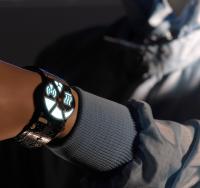Apr 26 2010
Every year, approximately 80,000 people in Germany fall ill from deep vein thrombosis. This type of occlusion is caused by blood clots and may lead to pulmonary embolism or serious heart attacks.
 Plastic chips monitor body functions
Plastic chips monitor body functions
Airline passengers long distance flights can be particularly affected with deep vein thrombosis. Assessing the risk of travel-related thrombosis may soon be possible with a new, advanced measuring device from IZM. Air passengers can get instant results simply by releasing a drop of blood on the measuring device. This lab-on-a-chip is made from plastic to minimize production costs. European researchers are in the process of developing necessary foundations for this plastic chip.
According to Professor Karlheinz Bock, division head, Polytronic Systems, IZM, the lab-on-a-chip shows possibilities of using polytronics to design bio-monitoring devices. He further stated that affordable, multifunctional systems are needed in a networked world. For instance, in Assisted Living infrastructure, electronic systems have to be manufactured in large-scale quantities in a cost-effective way. Such low-cost production can be achieved through polymer electronics, which are a combination of both electronics and functional materials. These materials can be easily broken up and recaptured via a printing process to make handy diagnostic systems. The small and easy-to-use systems make things easier for sick and elderly patients.
Top European research institutes and high-tech companies are involved in the process of engineering diagnostic systems for thrombosis. The key part of the analytical device, lab-on-chip, is a high-precision cartridge that can be used for blood analysis. The cartridge contains a polycarbonate plate that joins two main components in a single device. These components include foils that contain a delicate network of gold sensors, conductor lines, and a deep fluid channel. Within the sensor chamber, antibodies are attached to the electrodes that analyses blood clotting markers. Higher number indicates a risk of blood clot formation.
The diagnostic system is suitable for smokers, airline passengers, obese and stroke patients, and pregnant women. The diagnostic system, similar to glucose tests, requires a drop of blood and a hand-held scanner. An EU project is testing the feasibility of using this diagnostic system.
IZM has also deigned a sensor wristband that screens vital body functions of athletes and aged persons. The sensor wristband resembles a plastic wristband and features an electroluminescent display that shows the actual body temperature at any given time. The device also helps in detecting skin dehydration. In pacemaker patients, the sensor shows the strength of electromagnetic or electric fields. If required, the sensors can be combined with the polytronic platform.
The sensor wristband combines both conventional and polymer electronics. Sensors, polymer resistances and lighting elements, which are printed on the foils, are joined together with silicon circuits. Other elements include a resonance circuit with an engraved coil and an interdigital capacitor. The former records the electric smog, while the latter detects skin moisture. The sensor also contains comb-shaped copper bands that measure the body temperature.
Bosh clarified that sensors and optical functions are printed on the foils via a combination of lithographic and technical printing processes. The sensor wristwatch, similar to the diagnostic device, can be designed in a cost-effective way, either as individual sheets or roll-to-roll design.